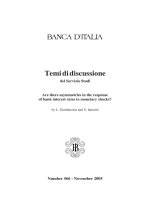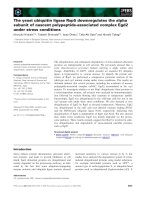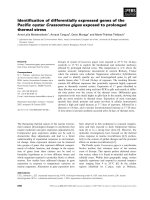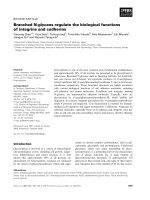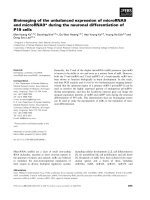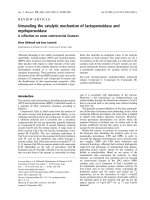SIGNALING MECHANISMS THAT SUPPRESS THE ANABOLIC RESPONSE OF OSTEOBLASTS AND OSTEOCYTES TO FLUID SHEAR STRESS
Bạn đang xem bản rút gọn của tài liệu. Xem và tải ngay bản đầy đủ của tài liệu tại đây (7.5 MB, 134 trang )
SIGNALING MECHANISMS THAT SUPPRESS THE ANABOLIC RESPONSE
OF OSTEOBLASTS AND OSTEOCYTES TO FLUID SHEAR STRESS
Julia M. Hum
Submitted to the faculty of the University Graduate School
in partial fulfillment of the requirements
for the degree
Doctor of Philosophy
in the Department of Cellular and Integrative Physiology
Indiana University
September 2013
!
ii
Accepted by the Faculty of Indiana University, in partial
fulfillment of the requirements for the degree of Doctor of Philosophy.
_____________________________
Fredrick M. Pavalko, Ph.D., Chair
_____________________________
Joseph P. Bidwell, Ph.D.
Doctoral Committee
_____________________________
Richard N. Day, Ph.D.
August 13, 2013
_____________________________
Jeffrey S. Elmendorf, Ph.D.
_____________________________
Alexander G. Robling, Ph.D.
!
iii
DEDICATION
This dissertation is dedicated to my family. I could not have made this
journey through graduate school without their continued support. I would like to
thank my husband, Houston, for his love, encouragement, and patience
throughout my graduate career. To my parents, thank you for instilling in me the
values necessary to succeed in all areas of life, both academic and personal.
Thank you for championing all my dreams and aspirations. To my two brothers,
thank you for serving as reminder of what is really important and always bringing
more humor into my life. I also want to thank my extended family and friends for
their encouragement throughout my academic journey.
!
iv
ACKNOWLEDGEMENTS
I would like to thank my mentor Dr. Fred Pavalko for the opportunity to
work as a graduate student in his lab. During my training he epitomized the role
of a mentor, he challenged me to grow as a researcher, helped me mature into
an independent and critical thinking scientist, while also encouraging me to learn
new methodologies to help achieve the goals of my research project. His
guidance has been pivotal in my transition from a training graduate student into a
full participating member of the scientific community.
Next, I thank the members of my graduate research committee, Drs.
Joseph Bidwell, Richard Day, Jeffrey Elmendorf, and Alexander Robling for their
insight and support during my training. They have helped me gain an
appreciation for always considering the impact of research in a greater context.
Thank you for always being a source of guidance and encouragement during my
graduate training.!
! I also thank past members of Dr. Fred Pavalko’s lab for their training,
friendship, and providing an enjoyable work environment. I especially thank Drs.
Marta Alverez and Suzanne Young for teaching me new techniques and always
providing thoughtful input. I also thank April Hoggatt and Rita Gerard-O’Riley
their assistance in aiding my research. I am grateful to the entire faculty and staff
of the Department of Cellular and Integrative Physiology for their assistance
throughout my training. I would also like to express deep gratitude to a number
of other friends I’ve encountered throughout graduate school including Brent
!
v
Penque, Min Cheng, Soyoung Park, Nolan Hoffman, Paul Childress, and
Amanda Siegel for their support.
Finally, I’d like to acknowledge Drs. Kathy Marrs and Mariah Judd for their
guidance while I served as a Teaching Fellow for the National Science
Foundation’s GK-12 Teaching Fellowship. Additionally, I’d like to thank Chris
Finkhouse, my teaching partner at Southport High School, for giving me the
opportunity to teach in his classroom and imparting invaluable wisdom about the
art of teaching.
!
vi
ABSTRACT
Julia M. Hum
SIGNALING MECHANISMS THAT SUPPRESS THE ANABOLIC RESPONSE
OF OSTEOBLASTS AND OSTEOCYTES TO FLUID SHEAR STRESS
Bone is a dynamic organ that responds to its external environment. Cell
signaling cascades are initiated within bone cells when changes in mechanical
loading occur. To describe these molecular signaling networks that sense a
mechanical signal and convert it into a transcriptional response, we proposed the
mechanosome model. “GO” and “STOP” mechansomes contain an adhesion-
associated protein and a nucleocytoplasmic shuttling transcription factor. “GO”
mechanosomes functions to promote the anabolic response of bone to
mechanical loading, while “STOP” mechanosomes function to suppress the
anabolic response of bone to mechanical loading. While much work has been
done to describe the molecular mechanisms that enhance the anabolic response
of bone to loading, less is known about the signaling mechanisms that suppress
bone’s response to loading. We studied two adhesion-associated proteins, Src
and Pyk2, which may function as “STOP” mechanosomes. Src kinase is
involved in a number of signaling pathways that respond to changes in external
loads on bone. An inhibition of Src causes an increase in the expression of the
anabolic bone gene osteocalcin. Additionally, mechanical stimulation of
!
vii
osteoblasts and osteocytes by fluid shear stress further enhanced expression of
osteocalcin when Src activity was inhibited. Importantly, fluid shear stress
stimulated an increase in nuclear Src activation and activity. The mechanism by
which Src participates in attenuating anabolic gene transcription remains
unknown. The studies described here suggest Src and Pyk2 increase their
association in response to fluid shear stress. Pyk2, a protein-tyrosine kinase,
exhibits nucleocytoplasmic shuttling, increased association with methyl-CpG-
binding protein 2 (MBD2), and suppression of osteopontin expression in
response to fluid shear stress. MBD2, known to be involved in DNA methylation
and interpretation of DNA methylation patterns, may aid in fluid shear stress-
induced suppression of anabolic bone genes. We conclude that both Src and
Pyk2 play a role in regulating bone mass, possibly through a complex with
MBD2, and function to limit the anabolic response of bone cells to fluid shear
stress through the suppression of anabolic bone gene expression. Taken
together, these data support the hypothesis that “STOP” mechanosomes exist
and their activity is simulated in response to fluid shear stress.
Fredrick M. Pavalko, Ph.D., Chair
!
viii
TABLE OF CONTENTS
List of Figures ix
List of Abbreviations xi
Chapter I Introduction 1
Chapter II Materials and Methods 40
Chapter III Nuclear Src Activity Functions to Suppress the Anabolic
Response of Osteoblasts and Osteocytes to Fluid
Shear Stress 47
Chapter IV Pyk2 May Function as a “STOP” Mechanosome By
Interacting with MBD2 in Osteoblasts and Osteocytes 75
Conclusions and Perspectives 90
References 94
Curriculum Vitae
!
ix
LIST OF FIGURES
Figure 1 16
Figure 2 22
Figure 3 26
Figure 4 37
Figure 5 52
Figure 6 53
Figure 7 54
Figure 8 55
Figure 9 58
Figure 10 59
Figure 11 61
Figure 12 62
Figure 13 64
Figure 14 65
Figure 15 66
Figure 16 67
Figure 17 80
Figure 18 81
Figure 19 83
Figure 20 85
!
x
Figure 21 86
Figure 23 92
!
xi
ABBREVIATIONS
AP1 Activator protein-1
ATP Adensosine triphosphate
BMP Bone morphogenetic protein
Cox-2 Cyclooxygenase-2
ECFP Enhanced cerulean fluorescent protein
ECM Extracellular matrix
ERK Ras-extracellular signal-regulated kinase
FAK Focal adhesion kinase
FA Focal adhesions
FAT Focal adhesion targeting
FBS Fetal bovine serum
FCS Fetal calf serum
FERM 4.1-ezrin-radixin-moesin
FLIM Florescent lifetime imaging microscopy
FP Fluorescent protein
FRET Förster resonance energy transfer
GFP Green fluorescent protein
GPCR G-protein coupled receptor
IĸB Inhibitor ĸB
ILK Integrin-linked kinase
IP
3
Inositol triphosphate
!
xii
JNK c-Jun NH
2
-terminal kinase
Lef1 Lymphoid enhancer-binding factor 1
LRP5/6 Low-density lipoprotein receptor-related protein 5
p130Cas Crk-associated substrate p130
MAPK Mitogen activated protein kinase
MBD2 Methyl-cpG binding protein 2
MC3T3 Mouse calvarial 3T3
MCOB Mouse calvarial osteoblasts
MeCP1 Methyl CpG binding protein 2
MEM-α Minimum essential media alpha
MLO-Y4 Murine long bone osteocyte-Y4
NFĸB Nuclear factor kappa-light-chain-enhancer of activated B cells
NES Nuclear export sequence
NLS Nuclear localization sequence
NMP4 Nuclear matrix protein 4
OCL Osteocalcin
OFSS Oscillatory fluid shear stress
OPN Osteopontin
PGE
2
Prostaglandin E2
PI-3K Phosphoinositide 3-kinase
PR Proline rich
PTH Parathyroid hormone
Pyk2 Proline-rich tyrosine kinase 2
!
xiii
qRT-PCR Quantitative real-time polymerase chain reaction
RANKL Receptor activator of nuclear factor-κB ligand
SH Src homology
SH1 Src homology 1
SH2 Src homology 2
SH3 Src homology 3
SH4 Src homology 4
SSRE Shear stress response element
TNFα Tumor necrosis factor α
!
1
!
Chapter I
INTRODUCTION
Mechanical Regulation of Bone
Bone Development
The skeleton serves to protect, support, and act as a reservoir for
metabolic activity. It must be rigid enough to protect the vital organs of the body,
lightweight to support mobility, yet also capable of adapting to its external
environment (Ehrlich and Lanyon, 2002). Bone is a highly specialized form of
connective tissue and a dynamic organ which develops through two different
types of formation, intramembranous and endochondral (Miller et al., 2007).
Intramembranous bone formation is direct bone synthesis mediated by the inner
periosteal osteogeneic layer. Endochondral bone formation results in indirect
synthesis of bone from a cartilage scaffold and is responsible for the
development of long bones in the longitudinal direction. Bone development
begins with a phase called modeling, a metabolic activity involving the deposition
of mineralized tissue where a cartilage equivalent existed (Raisz, 1999). During
modeling, endochondral bone formation systematically replaces cartilage with
bone. Remodeling follows the modeling phase, while remodeling begins in early
fetal development, it is the primary metabolic activity occurring in a fully formed
skeleton. In general, bone remodeling is a finely tuned cellular process that
involves the concerted efforts of osteoblasts, which secrete bone matrix, and
!
2
!
osteoclasts, which resorbs the bone matrix. If the balance of bone remodeling is
slightly shifted it can lead to a metabolic diseases such as osteoporosis or
osteopetrosis (Boyce et al., 1992).
More specifically, remodeling is a highly regulated, multi-step process
initiated by the interactions of cells from the hematopoietic osteoclastic and
mesenchymal osteoblastic lineages (Miller et al., 2007). Remodeling begins
when these two types of precursor cells interact, causing the formation of large
multinucleated osteoclasts. Osteoclasts function to resorb bone by attaching
directly to the surface of bone and secreting enzymes and hydrogen ions to
degrade the bone matrix. Osteoclasts form resorption pits on the surface of
bone, subsequently increasing the local calcium concentration and signaling the
reversal stage. During the reversal stage mononuclear cells release growth
factors and deposit proteoglycans on the surface of bone. Bone is formed during
the final formation stage, in which osteoblasts line the resorption pit and deposit
a mineralizable matrix. During the formation phase some osteoblasts become
entombed in the new bone matrix and mature into osteocytes. Osteocytes
account for 90-96% of mature bone tissue and are responsible for the
maintaining the bone matrix (Schaffler and Kennedy, 2012). Each osteocyte
resides in a lacuna within the bone matrix, and extends processes through the
canaliculi to connect with processes from adjacent osteocytes. This creates a
large osteocyte communication network, made up of osteocytic processes within
the bone matrix. In summary, while the skeleton may appear to be a rigid
!
3
!
structure, the bone tissue comprising our skeletal system undergoes dynamic
remodeling which can be initiated in different ways.
Regulation of bone formation and remodeling
Two of the main mechanisms by which new bone formation occurs,
include hormonal regulation and mechanical loading (Miller et al., 2007; Sheffield
et al., 1987). Both vitamin D and parathyroid hormone (PTH) function to regulate
calcium and have a major effect on bone remodeling (Blair et al., 2002; Suda et
al., 2003). In general, vitamin D serves to reduce bone formation, while PTH
serves to promote bone formation. Briefly, vitamin D regulates phosphorous and
calcium transport and promotes osteoclast differentiation (Bikle, 2012). Both
vitamin D and PTH increase osteoclast formation indirectly through increased
production of the receptor activator of NF-ĸB ligand (RANKL) in osteoblasts.
Osteoclast differentiation and maturation occur when RANKL binds to RANK
receptors on the surface of osteoclast precursors (Blair et al., 2002; O'Brien et
al., 1999; Suda et al., 2003). When serum calcium levels are low PTH is
secreted and activates both osteoclast and osteoblast differentiation (Blair et al.,
2002).
In contrast to their effects on osteoclasts, vitamin D and PTH oppose each
other’s effects on osteoblast differentiation. PTH promotes osteoblast survival in
vitro and increases osteoblast differentiation by activating the Runx2 transcription
factor (Jilka et al., 1999; Krishnan et al., 2003; Merciris et al., 2007;
Selvamurugan et al., 2000). Runx2 was the first osteoblast specific transcription
!
4
!
factor identified (Ducy et al., 1997; Otto et al., 1997) and is considered the
“master” regulator for bone formation (Ducy et al., 2000; Franceschi, 1999;
Komori et al., 1997). Overall PTH functions to increase bone formation by
osteoblasts and mineral degradation by osteoclasts (Blair et al., 2002).
Alternatively, vitamin D functions to inhibit osteoblast differentiation by negatively
regulating Runx2 and type-I collagen, but is required for bone degradation and
mineralization (Blair et al., 2002; Ducy et al., 1997; Suda et al., 2003). Hormonal
signals target all three kinds of bone cells to cause changes in gene transcription,
resulting in either enhanced or reduced bone formation via the remodeling
process.
Mechanical loading of the skeleton also induces bone formation, through
the regulation of the bone remodeling process. It has long been established that
bone responds to changes in its external environment and new bone formation
occurs in response to mechanical loading (Goodship et al., 1979; Lanyon, 1984;
Lanyon and Rubin, 1984; Wolff, 1892). Reducing mechanical load, for instance
during space flight or prolonged bed rest, causes bone loss (Collet et al., 1997;
Vogel and Whittle, 1976). Bone responds differently to the magnitude and rate of
strain. High strain changing at fast rates induces more bone formation than low
strain or slow rate of strain (Honda et al., 2001; Mosley and Lanyon, 1998;
O'Connor et al., 1982; Rubin et al., 1987). This finding explains why high impact
exercises result in more bone formation than low impact activities (Nordstrom et
al., 1998a; Nordstrom et al., 1998b). Additionally, bones have a greater
osteogenic response to repetitive bouts of mechanical loading with rest periods
!
5
!
than persistent loading cycles (Robling et al., 2000). The external environment of
bone has a major impact on its architecture. The following sections will explain
the structure of bone, its biomechanical properties, and the major signaling
cascades that mediate the response to mechanical loading.
Structural and Mechanical Properties of Bone
In order for the skeleton to carryout its primary functions it must maintain
an architecture that is both strong and lightweight. Bone accomplishes this
structural feat by being curved, allowing bones to withstand remarkable amounts
of strain, but remain lightweight (Turner and Burr, 1993). Throughout its
development and growth, bone is adapting its shape to the external demands
placed on the skeleton (Balling et al., 1992). As previously described, bone
modeling and remodeling allow for maintenance of its unique architecture, as
well as adapt to its external environment (Robling et al., 2002).
The two main types of bone, cortical and trabecular, play distinctly
different structural and functional roles. Cortical bone is made up of a network of
highly organized, densely packed collagen fibrils forming concentric lamellae
(Marks and Hermey, 1996). Within cortical bone Haversian canals form channels
that contain the bone’s supply of blood vessels and nerves. Functionally, cortical
bone provides strength, protection, and mechanical support. Cortical bone is
found primarily in the long bones of the skeleton, for instance the arms and legs.
In contrast, trabecular bone is loosely organized and composed of a porous
matrix, allowing it to be adaptable and serve its metabolic functions primarily at
!
6
!
the ends of bone. Wolff first observed that trabecular bone was present at the
sites of maximum stress on bones, while areas of minor stress lacked trabecular
bone (Wolff, 1892). Frost elaborated further on Wolff’s observation in his
description of the mechanostat theory (Frost, 1987). Frost’s theory states that an
ideal strain range exists for bone. When increased strain is experienced by an
area of bone it responds by depositing new bone matrix in an effort to lower the
amount of strain. Likewise, if the strain experienced by bone is below the ideal
range, bone will be resorbed in an effort to revert back to the preferred range.
Over the years research has focused on explaining the molecular
mechanisms that bone uses to respond to its external environment. Studies
have measured the amount of strain on bone in vivo and methods have been
developed to investigate the effects of mechanical loading on bone (Hert et al.,
1971; O'Connor et al., 1982). These findings lead to the expansion of the field of
bone cell mechanotransduction.
Bone Cell Mechanotransduction
Mechanotransduction is the conversion of mechanical signals into cellular
biochemical responses (French, 1992). Examples of mechanotransduction in the
human body include, the role of blood flow in vascular tone (Davies, 1995), hair
cells’ ability to detect and amplify sound (LeMasurier and Gillespie, 2005), and
bone responding to changes in its external environment through remodeling
(Turner and Pavalko, 1998). The external environment of bone produces tension
and compression forces, causing bones to bend, resulting in fluctuating interstitial
!
7
!
fluid pressure throughout the lacuno-canalicular system. Changes in interstitial
fluid shear stress are seen across the surface of osteoblasts and osteocytes.
Mathematical models have estimated the physiologic range of fluid shear stress
within the lacunae and canalicular spaces to be between 8 – 30 dynes/cm
2
(Weinbaum et al., 1994). To further investigate mechanotransduction in bone
cells numerous models have been designed to mimic a mechanical stimulus on
bone cells, including hydrostatic pressure (Burger et al., 1992; Ozawa et al.,
1990; Shelton and el Haj, 1992), substrate distension (Meikle et al., 1984; Murray
and Rushton, 1990; Somjen et al., 1980) or bending (Bottlang et al., 1997;
Pitsillides et al., 1995), and fluid shear stress (Dewey, 1984; Frangos et al., 1985;
Sakai et al., 1999). While all of the aforementioned models have significantly
contributed to our understanding of mechanotransduction, bone cells appear to
be more responsive to fluid shear stress models than strain models (Owan et al.,
1997; Smalt et al., 1997). Further discussion of fluid shear stress models will
occur in a subsequent section.
Both osteoblasts and osteocytes are exposed to changes in interstitial
fluid flow (Hillsley and Frangos, 1994; Turner and Pavalko, 1998). However, the
osteocyte is thought to be the primary bone cell responsible for responding to
mechanical loads. Known as the “great communicator” osteocytes detect strain
from within their lacunae entombed in bone matrix (Bonewald, 2011; Cowin,
1998). A communication network is set up among osteocytes throughout the
bone matrix by their processes. The processes of osteocytes transmit
mechanical signals through their network via gap junction linkages (Cheng et al.,
!
8
!
2001a; Cheng et al., 2001b; Jiang and Cheng, 2001). Osteocytes’ role in
mechanical loading was highlighted in a seminal study in which osteocytes were
targeted for ablation leading to defective mechanotransduction in mice (Tatsumi
et al., 2007). One key difference between the response of osteocytes and
osteoblasts to mechanical loading is the secretion of sclerostin. A protein
product of the SOST gene, sclerostin is only secreted by osteocytes and is a
powerful inhibitor of bone formation (Brunkow et al., 2001). SOST null mice
exhibit increased bone formation and strength (Li et al., 2008). In response to
mechanical loading, osteocytes reduce sclerostin secretion, whereas the
secretion is increased under reduced loading (Robling et al., 2008). Thus it
appears that sclerostin secretion is a central mechanism by which osteocytes
control local osteogeneis. Mice, rats, and nonhuman primates treated with a
sclerostin-neutralizing antibody demonstrated increased anabolic bone formation
(Li et al., 2009; Li et al., 2010; Ominsky et al., 2011; Ominsky et al., 2010).
Sclerostin, a suppressor of anabolic bone formation, is proving to be a promising
target for pharmacological intervention. This type of osteogenic suppression is
the focus of this dissertation project.
Besides the secretion of sclerostin, osteocytes and osteoblasts otherwise
respond to mechanical loading by initiating similar signaling cascades. Many
complex signaling cascades work in concert to ensure bone responds properly to
its external environment. The main signaling cascades utilized by osteoblasts
and osteocytes to respond to changes in their external environment include
calcium, prostaglandins, MAPK, Wnt, growth factors, PTH, TNFα, and focal
!
9
!
adhesion (FA) integrin-mediated signaling cascades (Liedert et al., 2006;
Thompson et al., 2012). In general, most of these pathways lead to in changes
in bone cell proliferation, differentiation, metabolic activity, and survival.
A rapid increase in intracellular calcium (Ca
2+
) is one of the first cellular
responses to fluid shear stress (el Haj et al., 1999). Ca
2+
channels on the
plasma membrane are mechanosenstive and open in response to fluid shear
stress (Iqbal and Zaidi, 2005). A change in the plasma membrane’s potential is
triggered by the increased Ca
2+
, which causes the voltage-sensitive Ca
2+
channels to open, further increasing intracellular Ca
2+
(el Haj et al., 1999).
Subsequently, the cell releases adenosine triphosphate (ATP), which acts in an
autocrine/paracrine fashion, binding to the purigenic P2X receptors to cause
further extracelluar Ca
2+
entry into the cell (Li et al., 2005). Additionally,
phospholipase C is activated and cleavage of phosphoinositol-4,5-bisphosphate
into diacyglycerol and inositol trisphosphate (IP
3
) results from ATP binding to
P2Y receptors (Genetos et al., 2005). Intracellular stores of Ca
2+
are then
released when IP
3
then binds to its receptor on the endoplasmic reticulum
Prostaglandin release is a rapid and continuous occurrence throughout
the duration of fluid shear stress exposure (Bakker et al., 2001). As intracellular
Ca
2+
levels increase, PKC is activated and induces phospholipase A
2
to cleave
arachidonic acid from the plasma membrane (Kudo and Murakami, 2002;
Murakami and Kudo, 2002). Arachidonic acid is converted into prostaglandin-G
2
(PGH
2
) and H
2
by the rate limiting enzyme cyclooxygenase 2 (Cox-2)
(Herschman, 1994). Next, PGH
2
is converted into various eicosanoids including
!
10
!
prostaglandin E
2
(PGE
2
) and PGI
2
(Dubois et al., 1998). When prostaglandins
are secreted from a bone cell they are capable of autocrine and paracrine
signaling. The significance of prostaglandins on bone was demonstrated when
treatment with PGE
2
stimulated osteoblast differentiation (Zhang et al., 2002),
bone formation (Jee et al., 1985; Jorgensen et al., 1988), and increased release
of the important growth factor, insulin-like growth factor 1 (McCarthy et al., 1991;
Zaman et al., 1997). Additionally, the importance of Cox-2 was demonstrated by
showing that load-induced bone-formation was blocked by an inhibitor, NS-398
(Forwood, 1996). In response to fluid shear stress, an increase in Cox-2
expression is recognized as an indication of the anabolic response of bone cells
(Pavalko et al., 1998b).
Downstream of Ca
2+
increase and prostaglandin release, fluid shear stress
results in the activation MAPK signaling cascade, which functions to increase
bone cell proliferation and survival (Liedert et al., 2006). Periods of fluid shear
stress result in the activation of the extracellular signal-related kinase (ERK),
p38, mitogen activated protein kinases (MAPKs), and c-jun N-terminal kinase
(JNK) (Liedert et al., 2006; Martineau and Gardiner, 2001). All of these signaling
molecules target the upregulation of c-fos and c-jun expression, the two
components of the activator protein-1 (AP1) transcription factor. AP1 can bind to
the promoter region of many mechanoresponsive genes, affecting their
transcription in response to mechanical loading (Franceschi, 2003). Shear stress
response element (SSRE) is another significant transcription factor-binding site
activated in response to mechanical loading (Nomura and Takano-Yamamoto,
!
11
!
2000). A SSRE was found in several genes including the aforementioned COX-
2. In MC3T3 osteoblastic cells exposure to fluid shear stress induces an
increase in Cox-2 expression, mediated by AP-1, CCAAT/enhancer-binding
protein β, and cAMP-response element-binding protein (CREB) (Ogasawara et
al., 2001).
Mechanical stimulation leads to increased activity of the canonical Wnt
signaling pathway. During active signaling, a Wnt family member (Wnt 3, 5, or 7)
bind co-receptors Frizzled and low-density lipoprotein receptor-related protein 5/6
(LRP5/6), causing the accumulation of β-catenin (Lin and Hankenson, 2011;
Monroe et al., 2012). The central signaling protein of the Wnt signaling pathway,
β-catenin, translocates to the nucleus and associates with the transcription factor
LEF1 to activate transcription of target genes. When Wnt is unbound to its co-
receptors, β-catenin’s accumulation is prevented by glycogen synthase kinase-
3’s phosphorylation, targeting β-catenin for degradation. Fluid shear stress
induces β-catenin nuclear translocation in osteoblasts and osteocytes (Case et
al., 2008; Kamel et al., 2010; Norvell et al., 2004). In the bone field, intense
research interest has surrounded the canonical Wnt signaling pathway due to
recent major advances. Mutations in the LRP5 receptor result in dramatic
changes in bone mass. Activating mutations in LRP5 cause high bone mass
phenotype (Boyden et al., 2002; Little et al., 2002; Qiu et al., 2007), while
inactivating mutations cause a low bone mass phenotype (Gong et al., 2001; Qiu
et al., 2007). Furthermore, β-catenin is a central signaling component in bone
differentiation, formation, and maintenance. A conditional β-catenin knockout in
!
12
!
mesenchymal progenitor cells caused disrupted chondrocyte formation and
limited osteoblast differentiation (Day et al., 2005). Mice expressing an
osteoblast-specific β-catenin mutation had an osteopenic phenotype and an
abundance of osteoclasts (Holmen et al., 2005). β-catenin’s ability to serve as
an important component within fluid shear stress-induced mechansomes will be
discussed in a later section.
Upregulation of growth factors including insulin-like growth factor (IGF) I
and II, transforming growth factor (TGF) β1, vascular endothelial growth factor,
and bone morphogenetic protein (BMP) 2 and 4 occurs in response to
mechanical stimulation (Franceschi and Xiao, 2003; Papachroni et al., 2009).
These growth factors act through autocrine and paracrine mechanisms, via their
tyrosine and serine/threonine kinase receptors, and activate PI3K, MAPK, and
SMAD signaling cascades (Farhadieh et al., 2004; Hughes-Fulford, 2004; Mikuni-
Takagaki, 1999). For example, the induction of the BMP-2 pathway increases
the expression of the three most pivotal osteogenic transcription factors Runx2,
osterix, and Dlx5 (Lee et al., 2003).
Additionally, PTH signaling is also stimulated in response to mechanical
loading. PTH signals in bone cells through the G protein-coupled receptor
(GPCR) at the plasma membrane, inducing the activation of adenylate cyclase.
Consequently protein kinase A phosphorylates the CREB transcription factor,
which binds to the Cox-2 promoter (Ogasawara et al., 2001). Many of the
signaling pathways reviewed here lead to increased bone cell proliferation and
differentiation. However, it has been estimated that more than 70% of


